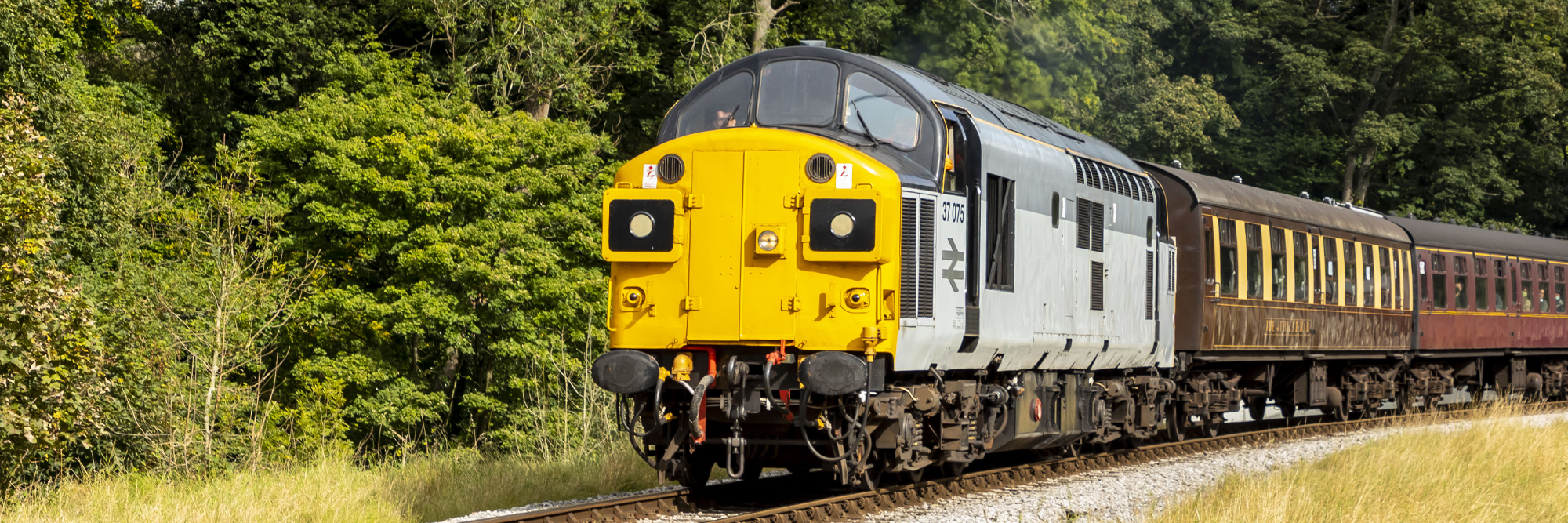A member of arguably the most successful class of diesel
Introduced in 1959, the Class 37 (British Railways Type 3) has outlasted almost all the other classes of mainline locomotives introduced as part of the BR modernisation plan of 1955. Members of the class, introduced over 5 years, members of the class can still be found on duties that they were built for over 55 years ago.
A nomadic existence both on the national network and in preservation
During its ‘national service’ life, 37 075 was allocated to nine different locations but as some were visited on more than one occasion, the total number of moves was 13. And that nomadic life continued into preservation with Haworth being its fifth location.
Data File
Built: 1962 Newcastle
Engine: English Electric 12CSVT
Main Generator: EE822
Auxiliary Generator: EE911/SC
Power at Rail: 932kN (1,250 hp)
Weight: 105 tons
Max Speed: 90mph
Max. T.E.: 247kN (55,500 lbf)
Cont. T.E: 156kN (35,000 lbf)
Numbers carried during working career: D6775, 37 075
From Teeside to the Fens, from freight to football supporters
This engine is another of the preferred types which came out of the 1955 B.R. Modernisation Plan and, as a Class of locomotive, has enjoyed longevity of use throughout the British Railways period and into the current era of privatisation. This Class was designed as a mixed traffic locomotive. They were able to haul freight and, with a top of speed of 90mph and having been fitted with steam heat capability, were just as suited to hauling express and local passenger services, also.
No. 37 075 was built by English Electric at their Robert Stephenson & Hawthorns plant and completed in 1962 as No. D6775. The locomotive was accepted by British Railways at Doncaster and then went on to be allocated to Thornaby Depot, Teeside. The locomotive gained its TOPS number of 37 075 in February 1974 and ran various freight and passenger trains including an Ipswich to Wembley Park Football Special train on 6th May 1978. The locomotive moved on a frequent basis around the country, being allocated to the following depots in this order: Hull (Diarycotes), Thornaby, March, Healey Mills, Tinsley (Sheffield), Thornaby, Stratford, Motherwell, Stratford, Thornaby, Tinsley and finally Thornaby.
The locomotive was first stored (as serviceable) in August 1994 and was officially declared unserviceable in December of that year. Ownership passed to EWS in September 1998 with No. 37 075 being recorded as “a stored mainline locomotive”.
Whilst allocated to Tinsley for the first time, the steam heating boiler, used to heat passenger coaches, was removed (November 1984). It is also worth noting that the noses, at each end of the locomotive, no longer match. One end has the original split head-code boxes but the other is of a later type, being completely flat and with no head-code boxes at all. This change is believed to have occurred due to accident damage, although we have not been able to ascertain the date of this incident.
The largest diesel locomotive on the KWVR
The locomotive was preserved in August 1999 (though only officially withdrawn from mainline service in November 1999) by the Class 37LA Group which saw the locomotive move initially to the Great Central (Nottingham) and later the Great Central Railway at Loughborough in 2000.
Reflecting its time in mainline ownership, its nomadic life was to continue when the 5C Locomotive Group bought the locomotive in 2002 and moved it to the Ecclesbourne Valley Railway, before moving it again two years later to the Churnet Valley Railway in 2007.
As is evident by its presence on the KWVR, 2012 saw 37 075 purchased by a consortium of KWVR volunteers and moved it to Haworth. The locomotive now sees use on passenger services and, when a larger engine is required, on works trains or other non-passenger duties.
37 075 has also starred on the small screen back in 2013 as part of the BBC drama ‘The Great Train Robbery’ where it had to masqueraded as the Class 40 D326. In 2019 the locomotive returned to the national network when it left the KWVR (towed) for a bogie swap with those belonging to Colas Class 37. 37 075 was fitted with high speed bogies and those on the Colas locomotive normal/lower speed bogies, the lower speed bogies being more suited to the KWVR.
